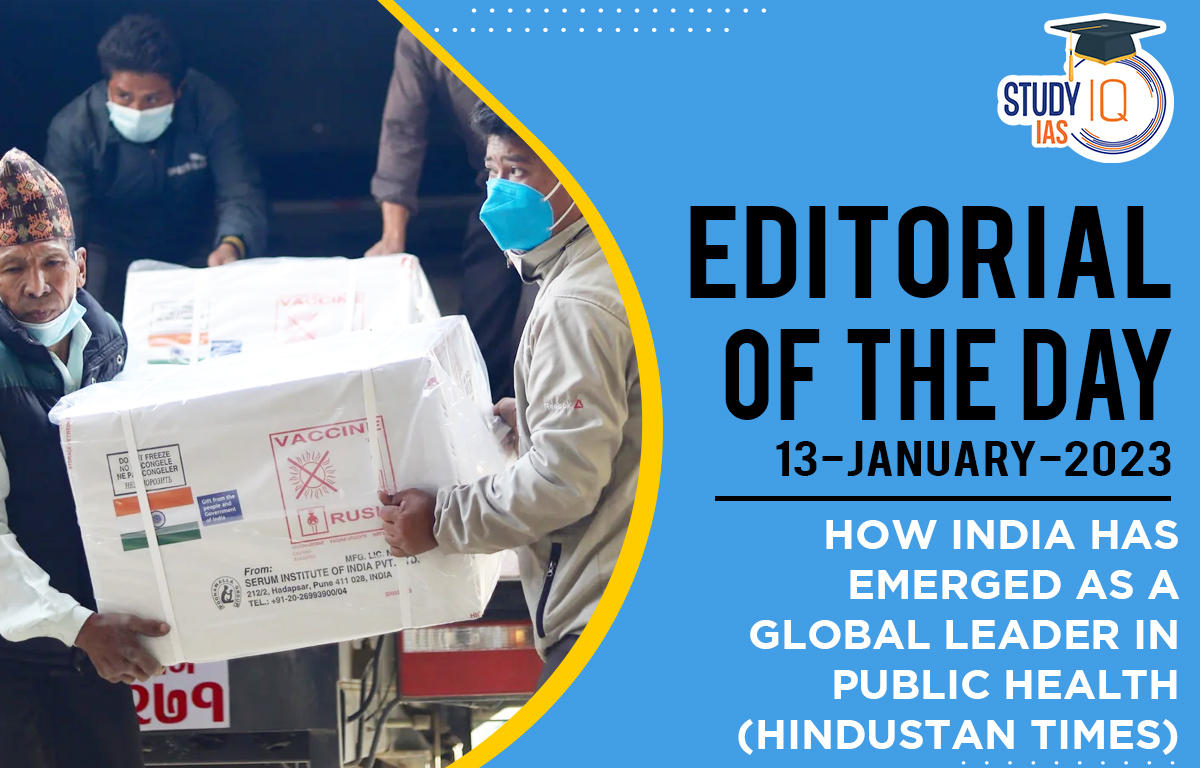Table of Contents
Exam View: India’s healthcare system, Potential of India’s Healthcare Sector, Issues Associated with India’s Healthcare Sector, Initiatives taken by Government.
Context: There has been a transition from a “can-do” attitude to a “will-do” determination. The country’s strategies to manage the pandemic exemplified this shift.
- India’s strategies to manage the pandemic show its presence as a global leader in public health. When oxygen demand spiked during the second wave of the pandemic in 2021, India installed and commissioned multiple oxygen systems across all its high caseload health facilities.
- India is known as the pharmacy of the world. India brought relief to the world by supplying essential drugs, commodities, and vaccines to many countries during the pandemic. India built capacities to manufacture and supply vaccines at affordable prices.
- India has emerged as a digital powerhouse by expanding its digital health infrastructure and is leading strategic discussions on leveraging Artificial Intelligence to improve public health. The country clocked the world’s highest volume of digital payments – more than the next five countries, including China, combined.
India Health Care System
India’s healthcare system is categorised into two major components public and private.
- The government, i.e., the public healthcare system, comprises limited secondary and tertiary care institutions in key cities and focuses on providing basic healthcare facilities in the form of primary healthcare centres (PHCs) in rural areas.
- The private sector provides a majority of secondary, tertiary, and quaternary care institutions with a major concentration in metros and tier-I and tier-II cities.
Potential of India’s Healthcare Sector
- Low cost of medical services: India is also cost-competitive compared to its peers in Asia and western countries. The cost of surgery in India is about one-tenth of that in the US or Western Europe.
- Well-trained medical professionals: India’s competitive advantage lies in its large pool of well-trained medical professionals.
- Medical tourism: The low cost of medical services has resulted in a rise in the country’s medical tourism, attracting patients from across the world. Moreover, India has emerged as a hub for R&D activities for international players due to its relatively low cost of clinical research.
- All the essential ingredients: India has all the essential ingredients for exponential growth in this sector, including a large population, a robust pharma and medical supply chain, 750 million plus smartphone users, 3rd the largest start-up pool globally with easy access to VC (Venture Capital Fund) funding and innovative tech entrepreneurs looking to solve global healthcare problems.
- Clusters for faster clinical testing: India will have about 50 clusters for faster clinical testing of medical devices to boost product development and innovation.
- Ayushman Bharat: 1,50,000 Ayushman Bharat centres, which aim at providing primary health care services to communities closer to their homes, are operational in India.
- The Indian healthcare sector is one of India’s largest employers: as it employs a total of 4.7 million people. The sector has generated 2.7 million additional jobs in India between 2017-22 – over 500,000 new jobs per year.
Issues Associated with India’s Healthcare Sector
- Insufficient Medical personnel: One of the most critical concerns is the gap in the doctor-patient ratio. According to the Indian Journal of Public, Health India needs 20 lakh doctors by 2030.
- Inadequate Medical Infrastructure: According to the National Health Profile, India has only 0.9 beds per 1000 population and out of which only 30% are in rural areas.
- Poor insurance penetration: The high out-of-pocket expenses in India stem from the fact that 76 per cent of Indians do not have health insurance.
- Lack of Standardisation of Quality Care: The quality of healthcare provided in India varies significantly, with inadequate facilities and resources in rural areas and poor regulation leading to substandard care in some private healthcare facilities.
- Crumbling public health infrastructure: There is a shortage of primary Health Centres (PHCs) (22%) and sub-health centres (20%), while only 7% of sub-health centres and 12% of primary health centres meet Indian Public Health Standards (IPHS) norms.
- Non-Communicable Diseases: Non-communicable diseases (NCDs) are responsible for over 60% of all deaths in India, with high rates of chronic illnesses such as diabetes, cancer, and heart disease. As a result, affordability concerns are also raised, and poor people are more vulnerable as a result.
- Lack of Adequate Mental Healthcare: India has one of the lowest numbers of mental healthcare professionals per capita.

Way Forward
- There is an urgency to focus on all three levels of primary, secondary and tertiary healthcare, it is imperative that the government look towards improving primary healthcare as a public good.
- There is a need for investing in the construction of new healthcare facilities and upgrading existing ones, as well as increasing funding for healthcare services (currently 2.1% of GDP) and medical research.
- The lesson emerging most unequivocally from the pandemic experience is that if India does not want a repeat of the immeasurable suffering and the social and economic loss, we need to make public health a central focus.
- There is also a need to declutter policy dialogue and provide clarity to the nomenclatures. There is also a need for enforcing regulations, implementing quality control measures, increasing transparency and conducting audits of health care programmes.
- Sustainable Health Governance could include implementing better management systems, strengthening healthcare regulatory bodies and creating independent oversight mechanisms to ensure more effective and efficient healthcare services.
India has set itself on course to becoming a developed country by 2047. It has demonstrated strong economic growth in the past decade, overtaking Britain to become the fifth-largest economy by nominal Gross Domestic Product (GDP). However, the journey to becoming a developed country cannot only be driven by the economy. Evidence shows that most developed countries invest more in health care. A developed country needs sustainable, elastic, and human-centric health systems.


 Current Affairs 23rd April 2024 for UPSC...
Current Affairs 23rd April 2024 for UPSC...
 Drug Discovery Process, Research Initiat...
Drug Discovery Process, Research Initiat...
 Criminalisation of Politics and its Impa...
Criminalisation of Politics and its Impa...

















